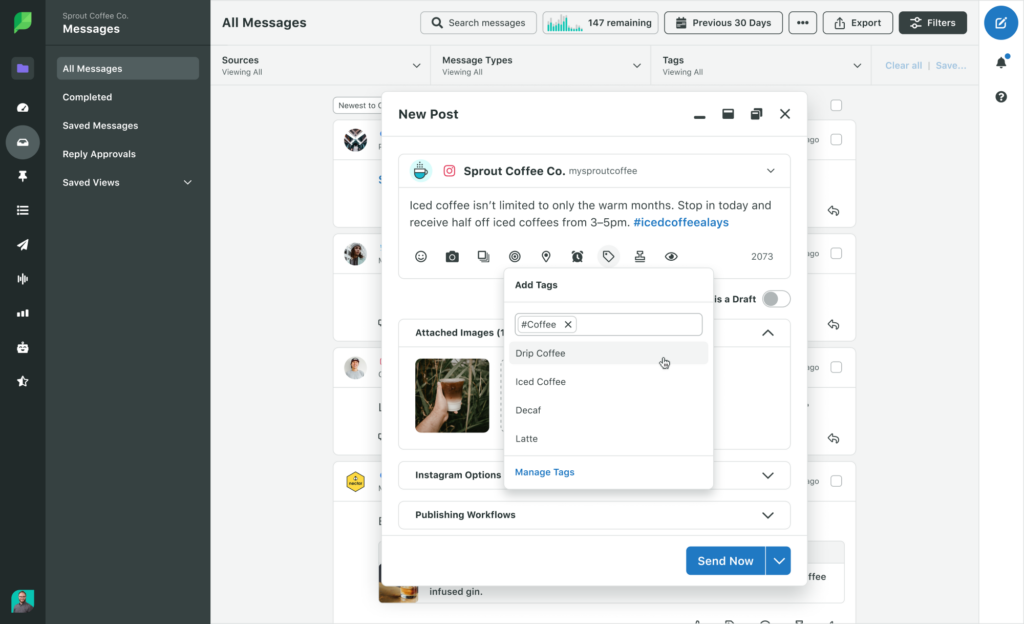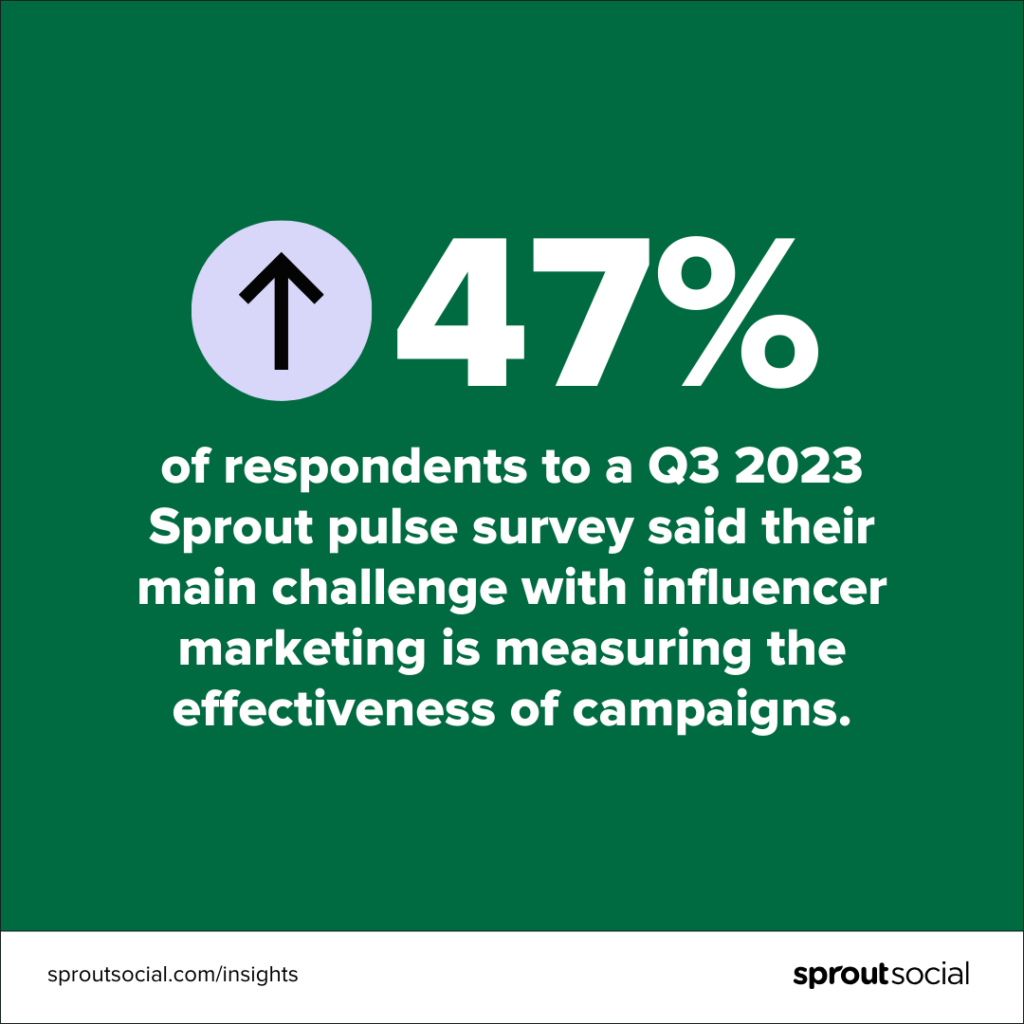What was the ROI of your influencer campaign? How does one topic perform on social compared to another? How are people responding to a campaign?
In social media, the most important questions are often the most difficult to answer or quantify. But these are questions you have to answer; not just for your team and strategy, but for your leadership and teams beyond marketing.
Luckily, there is a light at the end of the ask-hard-questions tunnel: Tags in Sprout reports. Sprout’s Tagging feature has changed the reporting game for many brands.
In this article, we’ll show you how 3 brands have created a Tagging strategy for marketing campaigns, cross-org reporting and better insights. Let’s dive in.
How 3 standout brands use a Tagging strategy for marketing campaigns, and beyond
To get you up to speed, Tags are a Sprout feature that act as labels you can attach to any piece of content you plan to publish. They can be the name of a campaign, the name of a creator partnership, a content bucket, a goal—whatever helps you organize content.
Using Tags allows you to filter social media reports to see specific content pieces, themes and posts, enhancing your social media insights. Think: honing in on campaign performance, uncovering how specific content themes perform on different platforms, seeing how your audience responds to different topics—the possibilities are endless.

We’re constantly impressed at the creative use cases people create for Tags—and the insights Tags help them uncover. Here are 3 brands who have developed a creative Tagging strategy for marketing campaigns and beyond, and how it empowers them to streamline otherwise complicated reporting processes.
Report on UGC and influencer content with Tags—River Island
There’s no denying the importance of creator and influencer partnerships. However, quantifying their success is difficult. According to a Q3 2023 Sprout pulse survey of 307 US-based social marketers, 47% of respondents said their main challenge with influencer marketing is measuring the effectiveness of campaigns.

London-based retailer River Island uses Tags to make this reporting process easier. In fact, they cite Sprout’s Tag Report as one of the most useful reports in Sprout for their team.
One of their stand-out use cases is how they use their Tagging strategy for marketing campaign reporting. For their team, this includes highlighting the performance of owned content vs. influencer content—a stellar way to showcase the effectiveness of influencer marketing.
As River Island’s team explains, “With the Tag Report, we can test and report on user-generated content (UGC) versus campaign imagery and determine which are more engaging. This helps us confidently allocate budgets to different creative assets.”
Apply it: Label influencer content you reshare or share with campaign-specific Tags to get a better understanding of the effectiveness of your influencer, creator and UGC campaigns.
Analyze the social conversation to create community-first content, faster—CareSource
Social media teams are no strangers to content audits. To truly create impactful content, you must be able to analyze and make data-driven content decisions more frequently—not just on a quarterly or yearly basis when larger content and strategy audits occur.
Healthcare non-profit CareSource has fine-tuned its content analysis to be more agile and to get more granular with content reporting. To do this, they tap into Tagging.
As CareSource’s Senior Director of Digital Strategy Sarah Chapman explains, “If we notice a trend in our monthly Tagging reports, like a sudden influx of questions about ID cards in August, then we realize this is likely related to parents needing back-to-school sports physicals and immunizations. So we plan ID card-related social content in August.”
This strategy uses customer care questions to inform content, and vice versa. Not only does CareSource tag their content depending on what content bucket—that is, what content theme and topic—they fall into; but they also tag incoming comments with the same tag as the original post. Using a specific Inbox Rule automates this process.
“When I produce a piece of content and tag it as a member benefit post when someone comments on that content, I have an Inbox rule that ensures the comment shares the same tag as the post,” Sarah explains.
Beyond helping them understand how content buckets perform on various platforms, this also enables them to get a pulse on their community’s conversation for enhanced reports.
As Sarah explains, “My team creates a monthly PowerPoint that shares insights, ‘ah-has’ and provides a high-level view and volume numbers of what the community was talking about last month. We get our insights directly from Sprout’s Tag Performance report to see what topics spiked—we can see if they spike on a day or around an event, and give insights that feel grounded in the community and don’t require someone to understand social speak.”
Rapid reporting leads to a smarter strategy and share-friendly stats. And their Tagging strategy has been a major time-saver, too. “It’s hard to quantify, but I would easily guess our team saves 10 hours a month just on having ready answers available for our team and others,” Sarah explains.
Apply it: Create a robust Tagging system for all of your content—including tags for each of your content buckets, campaigns and the platform each is posted on, for starters. Then, set up Inbox Rules that automatically tag any comments on specific posts to track what topics, content and themes may be driving the conversation, what that conversation might be and what the overall sentiment is in the comments section. This enables you to get more granular insights faster.
Get department-specific insights and report across your org—Grammarly
Social media has come a long way. According to The Sprout Social Index™, 76% of marketers agree their social insights inform other teams. And yet, 43% of marketers say they still feel siloed.
The value of social media extends far beyond the marketing team and has the power to inform and bolster every team at your org, but it’s important to tailor insights to other teams.

The Grammarly social team has incorporated cross-departmental report sharing into their process, breaking down social team silos. This has been especially impactful for their user experience, product and leadership teams.
Their robust Tagging strategy enables them to group incoming messages, like comments, based on the content—much like CareSource does—helping them tailor insights for specific teams, and to employ full enterprise reporting.
As Grammarly’s Community Manager Emma Hanevelt tells us, “Once a month, we combine Tagging insights from Sprout with Zendesk reports to create a deck that gets shared across the organization. It’s how we keep others up to date on trends and opportunities we’re seeing in customer support.”
But this Tagging strategy also enables the Grammarly team to filter department- and request-specific feedback to empower different teams. As Emma explains, “Tagging is one of the most important features for us. We can quickly pull specific feedback when needed. If any of our product managers come to us asking for messages on a certain product, we have it.”
Apply it: According to the Index, 57% of marketers share social metrics with executive leadership weekly or monthly. Use Tags to filter insights for in-depth and tailored reports for your leadership, and to create reports tailored for teams based on the insights that are most useful and relevant to their work.
How to implement Tagging in your marketing campaign reports today
Honing in on insights granular and broad. Providing cross-org knowledge. Speeding up decision-making. Proving the ROI of influencer partnerships; we’ve already highlighted the key benefits of Tagging on social media. Now let’s get into how to use it.
Jumpstarting your Tagging strategy for marketing campaigns in Sprout is easy—in fact, the process is baked into your publishing process, streamlined as part of the content creation process.
Start your free Sprout trial
Once in Sprout, all you need to do is:
- Navigate to the “Compose” icon—the paper and pencil image in the upper right-hand corner. Or click “Compose” on any day on the Sprout publishing calendar.

- Once you’ve added the copy and visuals for your post, click on the tag icon to select from a dropdown of your existing Tags, or to add new ones. If you’re in the full-screen compose window, navigate lower in the display to the “Sprout Tags” field and add Tags under “Labels.”

- To automatically tag incoming messages with the same Tags as the posts they’re attached to, set up auto-tagging: Navigate to your name in Sprout > Settings > Click Automated Rules under Global Features > Click Create new rule > Enter a rule title and description of what it does > select Inbox message for the Rule Type.
- Once you start tagging your content, dig into the data. You can filter general reports—like the Post Performance Report—by Tags to hone in on how topics or campaign posts perform. And the Cross-Network Tag Performance Report empowers you to filter and analyze Tag performance across platforms over your chosen time period.

Pro tip: This report is also shareable. This means next time leadership or teams outside of marketing ask you about how specific topics or campaigns perform, or what people are saying about a specific topic, you can quickly pull and send those insights directly from Sprout.
More impactful insights in less time: Try Sprout to simplify and streamline your reporting
New platforms, changing content formats, shifting algorithms, tight bandwidth—social teams are strapped for time as it is. But social media is an invaluable wealth of insights, for your marketing team and beyond.
Enabling your team to quickly answer tough questions from leadership, be more agile and share social insights with other teams is more than just a nice-to-have; it’s essential as social media becomes more influential.
To empower your team to work faster and smarter, try Sprout free for 30 days to see how a Tagging strategy for marketing campaigns changes your team, and entire business.